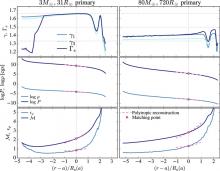
Abstract
This paper examines the properties of flows around objects embedded within common envelopes in the simplified context of a "wind tunnel." We establish characteristic relationships between key common envelope flow parameters like the Mach number and density scale height. Our wind tunnel is a three-dimensional, Cartesian geometry hydrodynamic simulation setup that includes the gravity of the primary and secondary stars and allows us to study the coefficients of drag and accretion experienced by the embedded object. Accretion and drag lead to a transformation of an embedded object and its orbit during a common envelope phase. We present two suites of simulations spanning a range of density gradients and Mach numbers—relevant for flow near the limb of a stellar envelope to the deep interior. In one suite, we adopt an ideal gas adiabatic exponent of  , in the other,
, in the other,  . We find that coefficients of drag rise in flows with steeper density gradients and that coefficients of drag and accretion are consistently higher in the more compressible,
. We find that coefficients of drag rise in flows with steeper density gradients and that coefficients of drag and accretion are consistently higher in the more compressible,  flow. We illustrate the impact of these newly derived coefficients by integrating the inspiral of a secondary object through the envelopes of
flow. We illustrate the impact of these newly derived coefficients by integrating the inspiral of a secondary object through the envelopes of  (
( ) and
) and  (
( ) giants. In these examples, we find a relatively rapid initial inspiral because, near the stellar limb, dynamical friction drag is generated mainly from dense gas focused from deeper within the primary-star's envelope. This rapid initial inspiral timescale carries potential implications for the timescale of transients from early common envelope interaction.
) giants. In these examples, we find a relatively rapid initial inspiral because, near the stellar limb, dynamical friction drag is generated mainly from dense gas focused from deeper within the primary-star's envelope. This rapid initial inspiral timescale carries potential implications for the timescale of transients from early common envelope interaction.